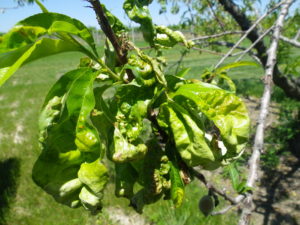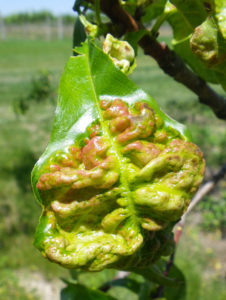There may still be time to protect Prunus spp. from Taphrina leaf curl.
Do you remember seeing red, curled, distorted, leaves on Prunus spp. last year and wondering what might have caused this symptom? Taphrina leaf curl, a fungal disease that survives in bark and bud scales, infects peaches and nectarines as well as ornamental flowering species of Prunus.
The symptoms of Taphrina leaf curl are very distinctive (Figure 1) and thus you definitely would have noticed this fungal disease if it was present in Prunus spp. last year. Infected leaves are severely puckered, distorted, thickened and reddish-to purple in color. (Figure 2) Premature leaf drop may also occur.
- Figure 1. Symptoms of Taphrina leaf curl on peach tree leaves in early Spring
- Figure 2. Distinctive leaf distortion and pink color due to Taphrina leaf curl
A single, thorough, preventative fungicide application is recommended during dormancy (after leaf drop in late fall but prior to bud swell in early spring before green leaf tips are first visible). Several fungicides are recommended for dormant applications. Check the Midwest Fruit Pest Management Guide for the most recent recommendations. Read and follow all label instructions to insure safety and maximum effectiveness.
If temperatures in your area have been such that visible bud swell has already occurred in Prunus spp., making it too late for a dormant application of fungicide then the recommended management for this year is to promote tree vitality through pruning, fertilization and watering.

